Making magic: What goes into creating an award-winning design?
by emily_smibert | February 15, 2017 12:00 am
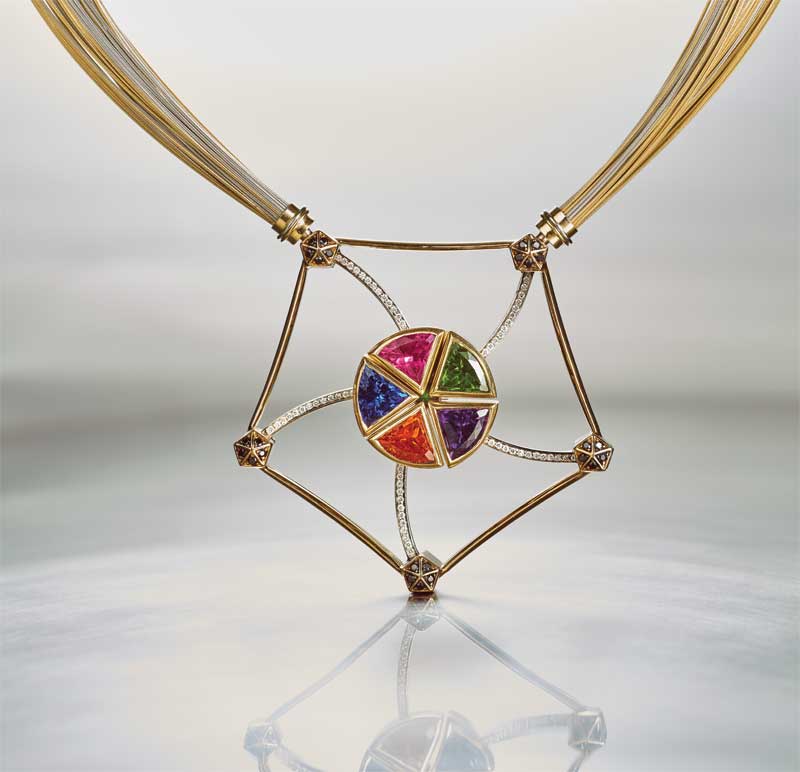
By Llyn L. Strelau
As my readers will know, I enjoy entering jewellery design competitions. One of the most challenging contests in the industry is the bi-annual German Jewellery and Gemstone Prize. Run by the gem dealers’ association based in Idar-Oberstein, Bundesverband der Edelstein- und Diamantindustrie e.V. The competition for finished jewellery design is held every second year, while intervening years focus on the gemstone arts of carving, faceting, and objets d’art. November 2016 marked the 47th annual awards. Unlike most competitions, this one offers significant cash prizes—a great incentive to one’s creativity when designing!
 [1]
[1]Officials also impose a theme each year. While some designers may find this restricting, I find having to interpret the designated theme in my own way adds to the challenge. Resultant entries and consequent winners show a great depth and breadth to the entrants’ creative abilities. Themes are usually announced at the awards presentation in November each year, preceding the following year’s competition. Last fall, however, the original theme for 2016’s competition, “Explosion,” had to be scrapped due to the tragic events in Paris and Belgium. It may have taken a few months for officials to name a new theme, but they succeeded and released, “It’s a Kind of Magic!” The category for young designers was themed, “I want to break free!”
Feeling inspired
My entry this year had its genesis two years ago while at Gem Fair Tucson with my friend and talented gem cutter, Stephen Avery. He had a fantastic five-stone suite and I fell in love with it immediately, sketching an initial design idea that day. The suite featured five pie-shape stones of amethyst, spessartite, tanzanite, pink tourmaline, and peridot—Avery has a great talent for combining colour, tone, and saturation to create harmonious groupings.
Despite my ability to visualize the gems being articulated, travelling along curved tracks, and coming together to create the full circle, or be moved in any position the wearer might choose, the gems and the idea lay dormant.
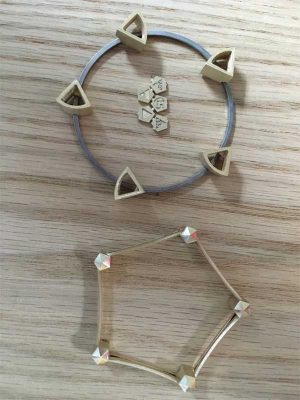 [2]
[2]From the ashes
Two years later, the theme for the German competition was announced, and I began researching the world of magic. Stumbling upon the five-fold pentagram, I tried many variations of the idea, but the standard pentagram star was not satisfying. I finally reverted to my earlier pencil sketch of a stylized version of the classic magical pentagram.
The pentagram has been used around the world as a mystical and religious symbol since the beginning of recorded history: Ancient oriental cultures recognized the five elements; Christians recognize the five wounds of Christ; Da Vinci related the pentagram to the human form in his Vitruvian Man; Alchemists embraced the pentagram and attached symbols of the five elements; Freemasons adopted the Pythagorean pentagram—it can be a controversial symbol.
Invoking the power of five
InterCHANGE is my trade-name for the jewellery designs I create incorporating the basic bayonet clasp hardware system invented by Jörg Heinz of Germany. The system provides great versatility and endless combinations of chains, pearls, clasps, and enhancers. My additional challenge was to incorporate my competition piece into the interCHANGE collection.
The pendant-clasp is crafted of 750 yellow gold and 950 platinum-cobalt alloy. A stylized pentagram with a five-sided frame, each curved segment contains a pentagonal terminal concealing the bayonet clasp mechanism. Each terminal is bead-set with round brilliant-cut black diamonds. Suspended in the outer frame, spiral five platinum guide rails, each set with round brilliant-cut white diamonds. Each of the guide rails hold one of the bezel-set fan-shaped, faceted coloured gemstones which come together and form a central circle. The bezels glide along the guide rails, made of magnetic cobalt-platinum. Rare earth magnets hidden behind each coloured stone retain the desired position. Once they are moved out from the centre, they reveal the oculus, or eye-stone—a hidden cabachon opal set in the pentagram’s centre.
There are many iterations and multiples of the magical number five in Pentagram: 100 0.005-carat white diamonds, 25 1.5-mm (0.06-in) black diamonds, 50 strands in the 18-karat yellow and white gold cable neckpiece, and by co-incidence—or magic—the five coloured gemstones have a total weight of 15 carats. The black diamonds contain both the sum of all colours and the absence of light. White diamonds set in the guide rails represent the purity of colour and light. The opal oculus contains the full spectrum of the five elemental gems.
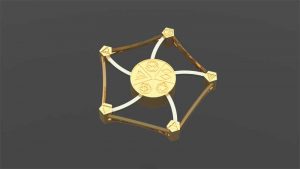
The five coloured gemstones signify the five elements of the pentagram. Embossed on the back of each of their bezels is the corresponding platonic solid or sacred geometry symbol of that element. The reverse of each terminal contains the alchemical symbol for the element it is connected to, as well:
- amethyst – spirit – dodecahedron
- spessartite – fire – tetrahedron
- tanzanite – water – icosahedron
- rubellite – air – octahedron
- peridot – earth – hexahedron
Seeking perfection
I often only use CAD to give a design direction, but I quickly realized this design required accuracy only CAD provides. Of course, a great deal of hand fabrication is also involved in achieving my ambitious design—the mechanics required for gems to move so precisely takes a great deal of experimentation. I must give full credit to Matthew Todhunter for his precision milling of a complex project and Michael Stone for the attention to detail in the casting, hand-fabrication, and stone setting. It was a magical team!
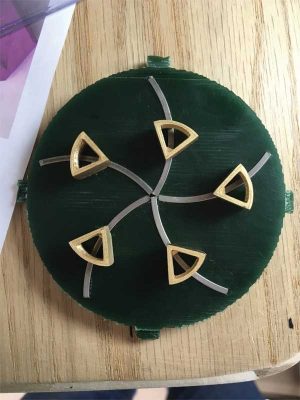
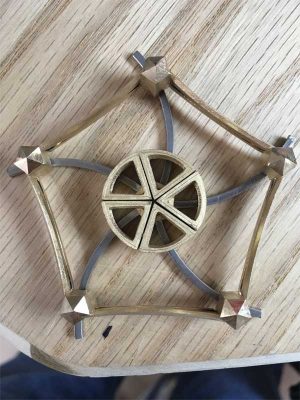
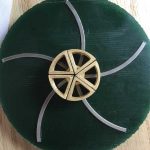 [3]
[3]At the bench
While the gems are similar in size and proportion, they vary slightly, especially in depth due to their individual refractive indices influencing the specific pavilion angles. Instead of surface modelling five unique gems, I create a single model that’s an average of the five gems. Next, the bezels are surface modelled and modified as necessary to ensure they form a complete circle when oriented at the pendant’s centre.
Once the gems and bezels are created, I have to figure out how to ensure the five platinum tracks will be consistent and have identical arcs, so the gemstones will move evenly. With experimentation, I decide a circle with a diameter of 65 mm (2.6 in.) will, when cut into five segments, provide a suitable arc for the tracks. I model these in CAD and initially consider having the tracks milled directly from the CAD file then cast in the cobalt-platinum. However, this will be more costly, as I’d have to purchase the extra platinum required for sprues and button.
More critically, however, is the possibility of the platinum tracks, which are extremely malleable after casting, deforming during finishing and diamond setting, losing their vital accuracy. So, I opt to mill 3 sq. mm (0.12 in.) platinum-cobalt wire down to 2 sq. mm (0.08 in.) without annealing, bend it into the 65-mm (2.6-in.) diameter circle, and laser-weld the seam. Careful use of a hammer and round section steel bracelet mandrel ensure the circle is true. The resultant component is then cut into five equal sections.To ensure the precise assembly of the segments, I go back to CAD and use the virtual model of the assembled track as a cutter to Boolean-subtract a corresponding recess from a solid block. This block is then milled and used as a jig to support the five pieces of track with the fabricated bezel for the opal oculus at the centre. The wax jig allows for perfect alignment of the tracks while they are laser-welded together.
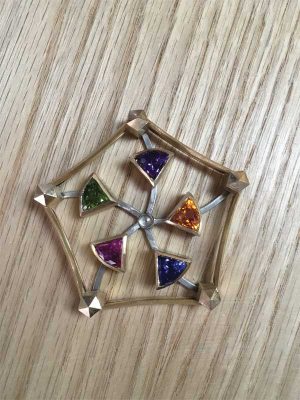
The main yellow gold frame is then milled in two halves, cast, polished, and assembled. The undersides of the five pentagonal terminals are left open and notched to allow the extremities of the five tracks to be slotted in. Next, the platinum tracks are bead-set with the half-point diamonds, and the five coloured gemstones are slid over their rail. The entire assembly is fit into the frame and laser-welded in place.
To finish the back of the piece, I modelled five pentagonal plates to cover the back of the terminals. These incorporated the five alchemical symbols for the elements with the addition of my trademark and quality stamps. The back plates for the five pie-shape bezels are to hold small rare earth magnets on their interior surface. The outside has embossed geometrical representations of the platonic solids for the five elements.
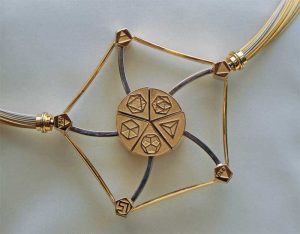
This step is where I ran into problems due to the severe time constraints I was under, as a result of the changed theme. It was not discovered until after the back plates were attached, with their rare earth magnets inserted, that the magnets were not quite strong enough to hold the combined weight of the gems and their bezels in place as planned. It was too late to do anything, so the piece was given its final polish and shipped to Germany to meet the competition deadline.
My finished design is not quite as magical as I had intended, but I know it’s possible to modify the back plates to hold more magnets—that is, of course, when it comes back from its grand European tour.
Always worth it in the end
As I’d hoped, the pentagram worked its magic. This October, my design entry placed third out of 55 entries—the only North American winner!
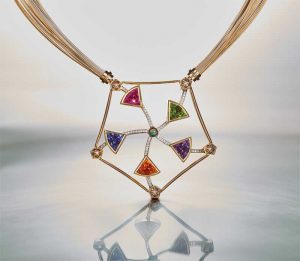
I want to encourage my fellow designers, and aspiring designers, to keep an eye out for future competition announcements; perhaps more Canadian designers will be on the winner’s podium next time?
Llyn L. Strelau is the owner of Jewels by Design in Calgary. Established in 1984, his by-appointment atelier specializes in custom jewellery design for local and international clientele. Strelau has received numerous design awards, including the American Gem Trade Association’s (AGTA’s) Spectrum Awards and De Beers’ Beyond Tradition—A Celebration of Canadian Craft. His work has also been published in Masters: Gemstones, Major Works by Leading Jewelers. Strelau can be reached via e-mail at designer@jewelsbydesign.com[4].
- [Image]: http://www.jewellerybusiness.com/wp-content/uploads/2017/02/IMG.jpg
- [Image]: http://www.jewellerybusiness.com/wp-content/uploads/2017/02/Assembly-progress.jpg
- [Image]: http://www.jewellerybusiness.com/wp-content/uploads/2017/02/Alignment-jig-closed.jpg
- designer@jewelsbydesign.com: mailto:designer@jewelsbydesign.com
Source URL: https://www.jewellerybusiness.com/features/making-magic-what-goes-into-creating-an-award-winning-design/